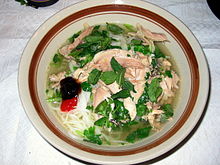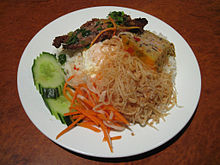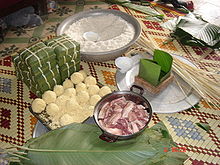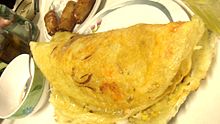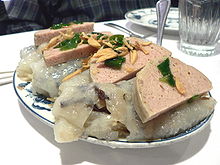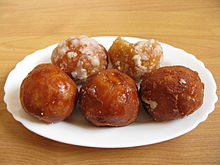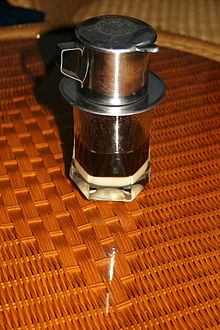- Vietnamese cuisine
-
Vietnamese cuisine is a style of cooking derived from Vietnam. Fish sauce, soy sauce, rice, fresh herbs, fruits and vegetables are commonly used. Vietnamese recipes utilize a diverse range of herbs, including lemongrass, mint, Vietnamese mint, long coriander and Thai basil leaves. Traditional Vietnamese cooking is greatly admired for freshness of the ingredients and for the healthy eating style.
The most common meats used in Vietnamese cuisine are fish, chicken, pork, beef, and various kinds of seafood. The Vietnamese also have a strong vegetarian tradition influenced by Buddhist values.
Regional variations
The mainstream culinary traditions in all three regions of Vietnam share some fundamental features:
- Freshness of food: Most meats are only briefly cooked to preserve their original textures and colors. Vegetables are rarely cooked; if they are, they are boiled or only briefly stir-fried.
- Presence of herbs and vegetables: Herbs and vegetables are used abundantly in Vietnamese cuisines. Vietnamese dishes are incomplete without herbs and vegetables.
- Broths or soup-based dishes are characteristic of all three regions
- Presentation: The condiments that accompany Vietnamese meals are usually colorful and arranged in eye-pleasing manners.
While sharing some key features, Vietnamese culinary tradition differs from region to region.
In Northern Vietnam, colder climate limits the production and availability of spices. As a result, the foods here are often less spicy than those in other regions. Black pepper is used in place of chiles as the most popular ingredient to produce spice flavor. In general, Northern Vietnamese cuisine is not bold in any particular flavor - sweet, salty, spicy, bitter, or sour. Most Northern Vietnamese foods feature light and balanced flavors that result from subtle combinations of many different flavoring ingredients. The use of meats such as pork, beef, and chicken were relatively limited in the past. Freshwater fish, crustaceans, and mollusks - such as prawns, shrimps, crabs, oysters, mussels - are widely used. Many notable dishes of Northern Vietnam are crab-centered (e.g., bún riêu). Fish sauce, soy sauce, prawn sauce, and lime are among the main flavoring ingredients. Being the cradle of Vietnamese civilization, Northern Vietnam produces many signature dishes of Vietnam, such as phở, bún riêu, bánh cuốn, which were carried to Central and Southern Vietnam through the road of Vietnamese migration.
The abundance of spices produced by Central Vietnam's mountainous terrain makes this region's cuisine notable for its spicy food, which sets it apart from the two other regions of Vietnam where foods are mostly non-spicy. Once the capital of the last dynasty of Vietnam, Hue's culinary tradition features highly decorative and colorful food, reflecting the influence of ancient Vietnamese royal cuisine. The region's cuisine is also notable for its sophisticated meals constituted by many complex dishes served at small portions. Chili peppers and shrimp sauces are among the frequently used ingredients. Some Vietnamese signature dishes produced at this region are bún bò Huế and bánh xèo.
The warm weather and fertile soil of Southern Vietnam create an ideal condition for growing a wide variety of fruit, vegetables, and livestock. As a result, foods in Southern Vietnam are often vibrant and flavorful with liberal uses of garlic, shallots, and fresh herbs. Sugar is added to food more than in the other regions. The preference for sweetness in Southern Vietnam can also be seen through the widespread use of coconut milk in Southern Vietnamese cuisine. Vast shorelines make seafood a natural staple for people in this region. Southern Vietnam has also been the region where influences from foreign cuisines (Chinese, Indian, French, Thai etc.) are most prominent.
External influences
As distinct as Vietnamese cuisine is, it has been influenced by several sources.
Due to historical connection with China, Vietnam shares many of its characteristics with China. In culinary traditions, Chinese introduced to Vietnam many dishes like hoành thánh (wonton), há cảo (dumpling), hủ tiếu (ka tieu), mì (wheat noodles), bò bía (Popiah), bánh quẩy (youtiao), bánh bao (baozi), cơm chiên Dương Châu (Yangzhou-fried rice), mì xào (chow mein)...Vietnamese adopted these foods and added their own styles and flavors to the foods. Ethnic minorities in the mountainous region near China-Vietnam border also adopted some foods from China. Ethnic Tày and Nùng in Lạng Sơn province adopted "thịt lợn quay" (roasted pork) and "khau nhục" (braised pork belly) from China.
The French introduced to Vietnam baguettes, which were then combined with Vietnamese stuffing to become a popular fast food in Vietnam called bánh mì and known overseas as "Vietnamese sandwich". The French also brought to Vietnam onions, potatoes, tarragon, asparagus, and coffee... Onions are called "hành tây" (literally "Western onion"), asparagus as "măng tây" (literally "Western shoots) and potatoes are called "khoai tây" (literally "Western yam") in Vietnamese, which reflect their origin before arriving to Vietnam.
From India by way of possibly the annexed Indianized kingdom Champa in central Vietnam or the Khmer Krom, Vietnamese adopted curry.Though not common in the North, cà ri is a quite popular dish in central and southern Vietnam. The most common form is the chicken curry and to a much less common dish is the goat curry. The chicken curry is an indispensable dish in many social gathering events such as weddings, funerals and the yearly death anniversary of a loved one. In Vietnam, the curry is eaten either with the French baguettes or with steamed rice. The round rice noodles (rice vermicelli) are sometimes eaten with the curry.
From the Khmer, Vietnamese adopted mắm bồ hóc (prahok). Mắm bồ hóc is used as a central ingredient of a Vietnamese rice noodle soup called "bún nước lèo" - a Vietnamese dish influenced by Khmer.
From Thailand, Vietnamese adopted xôi xoài (mango sticky rice) and lẩu Thái (Thai hotpot) - a very popular party food in Vietnam, especially in Saigon.
Cooking techniques
- Rán,Chiên: fried dishes.
- Xào: stir fry, sautéing.
- Kho: stew, braised dishes.
- Kho khô: literally dried stew (until the sauce thickens).
- Hầm: slow-cook with spices or other ingredients over a long period of time.
- Rim: simmering.
- Luộc: boiling with water, usually applied to fresh vegetables and meat.
- Hấp: steamed dishes.
- Om: clay pot cooking of Northern style.
- Gỏi: salad dishes.
- Nướng: grilled dishes.
- Nướng xiên: skewered dishes.
- Bằm: sauteed mixed of chopped ingredients.
- Cháo: congee dishes.
- Rô ti: roasting meat then bring to a simmer.
- Quay: roasted dishes.
- Lẩu: hot pot dishes.
- Rang: roasted/pop dishes.
Typical Vietnamese family meals
A typical meal for the average Vietnamese family would include:
- Individual bowls of steamed white rice
- Fish/seafood, meat (grilled, boiled, steamed, stewed or stir-fried with vegetables)
- Stir-fried, raw, and pickled, steamed, or fresh vegetables
- Canh (a clear broth with vegetables and often meat or seafood) or other Vietnamese-style soup
- Prepared fish sauce and/or soy sauce for dipping, to which garlic, pepper, chili, ginger or lime juice are sometimes added according to taste
- Small dish of relishes, such as salted eggplant, pickled white cabbage, pickled papaya, pickled garlic or pickled bean sprouts
All dishes apart from the individual bowls of rice are communal and to be shared.
Feast
Feast (Vietnamese: cỗ) is a significant event for families or a villages, usually 4 or 6 people for each table (5 people is unacceptable). Feast is prepared for weddings, funerals or in festivals, including wish-for-longevity ceremony. In a feast, ordinary foods are not served but boiled rice is still used. The well-known feast is the feast of 49 quan họ villages with cỗ năm tầng.
Vietnamese feast has two courses: main course (món mặn. Literally: salty dish) and dessert (món ngọt. Literally: sweet dish). All dishes, except for individual bowls of rice, are enjoyed collectively. All main course dishes are served simultaneously rather than subsequently. The most major dish of the main course is place in the centers of the tables, usually big pots of soup or hotpot.
Attendants are arranged into several groups according to their social status, genders, ages, their degree of acquantaince and their eating habits and preferences. It is a custom that female guests will bring some food and help the hosts to prepare the feast.
A basic feast (Vietnamese: cỗ một tầng) consists of ten dishes: five dishes in bowls (năm bát): bóng, miến (cellophane noodles), măng (bamboo shoot), mọc (meat ball), chim or gà tần (bird or chicken stew dishes) and five dishes in plates (năm đĩa): giò (Vietnamese sausage), chả, gà or vịt luộc (boiled chicken or duck), nộm (Vietnamese salad) and xào (stir-frying dishes). This kind of feast is original and is organized in the Northern Vietnam. Other variances are held in Central and Southern Vietnam.
Four dishes are indispensable in the feast of Tết are giò (Vietnamese sausage), nem (spring roll), ninh (stew dishes) and mọc (meat ball). In this time, the feast for offering ancestors includes: sticky rice, boiled chicken, Vietnamese rice wine, and other preferred foods by ancestors in the past.
Gifts are given before guests leave the feast.
Popularity
Outside of Vietnam, Vietnamese cuisine is widely available in countries with strong Vietnamese immigrant communities, such as Australia, the United States, Canada, and France. Vietnamese cuisine is also popular in Japan, Korea, Czech Republic, Germany, Poland, and Russia, and in areas with dense Asian populations.
In recent years, Vietnamese cuisine has become popular in other Southeast Asian countries such as Laos, and Thailand.
Dishes that have become trademarks of Vietnamese cuisine are phở, gỏi cuốn (spring/summer rolls), bún, and bánh mì (Vietnamese baguette).
Television shows featuring Vietnamese food have increased its publicity. On The Great Food Truck Race, a vietnamese sandwich truck called Nom Nom Truck received the most money in the first five episodes. Anthony Bourdain wrote for the Financial Times in 2005, “A year from now, I plan to live here. I will move to a small fishing village in a coastal area of Vietnam near Hoi An. I have no idea what I'm going to do there, other than write about the experience. I plan only on being a visual curiosity, the lone westerner in a Vietnamese community; to rent a house, move in with few, if any, expectations and let the experience wash over me. Whatever happens, happens.”
Philosophical influences on Vietnamese cuisine
Yin Yang balance
The principle of yin and yang is applied in selecting the ingredients of a dish and the dishes of a meal, in matching dishes with seasonal or climatic conditions, with the prevalent environment and with the current physical well-being of the diners.
Some examples are:[citation needed]
- Duck meat is considered "cool" so is served in summer, which is hot, and with ginger fish sauce, which is "warm." On the other hand, chicken, which is "warm," and pork, which is "hot," are used in cold winters.
- Seafood ranging from "cool" to "cold" are suitable to use with ginger ("warm").
- Spicy, which is extremely yang, must be harmonized by sour, which is extremely yin.
- Balut- "Hột vịt lộn," meaning " Upside-down egg" ("cold"), must be combined with Vietnamese mint "Rau răm" ("hot").
- Cold and flu patients must drink ginger water ("hot").
Five element correspondence
Vietnamese cuisine is influenced by the Asian principle of five elements and Mahābhūta.
Many Vietnamese dishes include five spices (Vietnamese: ngũ vị): spicy (metal), sour (wood), bitter (fire), salty (water) and sweet (Earth), corresponding to: five organs (Vietnamese: ngũ tạng): gall bladder, small intestine, large intestine, stomach and urinary bladder.[citation needed]
Vietnamese dishes also include five types of nutrients (Vietnamese: ngũ chất): powder, water or liquid, mineral elements, protein and fat.
Vietnamese cooks try to have five colours (Vietnamese: ngũ sắc): white (metal), green (wood), yellow (Earth), red (fire) and black (water) in their dishes.
Dishes in Vietnam appeal to gastronomes via five senses (Vietnamese: năm giác quan): food arrangement attracts eyes, sounds come from crisp ingredients, five spices detected on the tongue, aromatic ingredients coming mainly from herbs stimulate the nose and some meals, especially finger food, can be perceived by touching.
Cultural importance
Salt is used as the connection between the world of the living and the world of the dead. Bánh phu thê is used to remind new couples of perfection and harmony at their weddings. Food is often placed at the ancestral altar as an offering to the dead. Cooking and eating play an extremely important role in Vietnamese culture. The word ăn (eat) is included in a great number of proverbs and has a large range of semantic extensions.
Proverbs
Examples:
- Ăn coi nồi, ngồi coi hướng (lit. "Checking the status of the rice pot when eating, watch where/what direction you are sitting.") = Be careful of possible faux pas(es).
- Ăn theo thuở, ở theo thì = Living in accordance to one's limit and social circumstance. A variation of "In Rome, do as Romans do" (within your means)
- Cha ăn mặn, con khát nước (lit. "Father eats salty food, the children will be thirsty.") = Bad actions will later bring bad luck/consequences to descendants.
- Ăn kĩ no lâu, cày sâu tốt lúa (lit. Eating carefully [make you] feel full longer, ploughing deep is good for the rice) = Careful execution brings better results than hasty actions.
Semantic extensions
Examples:
- Ăn nói (lit. eating speaking) = Speaking (chosen in context of care, consideration, courtersy)
- Ăn ở (lit. eating living) = [one's] behavior and/in dealing with others.
- Ăn nằm (lit. eating lying down) = A rather polite folksy way of saying having sex.
- Ăn mặc (lit. eating putting on cloth) = [state of] Dressing [usually in context of comments from others]
- Ăn xài (lit. eating spending) = Spending money, buying stuff, usually used in context of extravagance.
- Ăn diện (lit. eating dressing up) = Dressing up, usually used in context of extravagance.
- Ăn thua (lit. Winning losing) = Various. Không ăn thua (lit. No winning losing) = Having no effect at all. Ăn thua đủ (lit. winning losing full)= Fully committed to protest/argument/action regardless of the outcome whatsovever.
- Ăn chơi (lit. eating playing) = Extravagant lifestyle, playboy-like lifestyle.
Popular dishes
For a longer list of popular dishes, see List of Vietnamese dishes. For a list of popular dishes organized by province, see List of Vietnamese culinary specialities.When Vietnamese dishes are referred to in English, it is generally by the Vietnamese name with the diacritics left off. Some dishes have gained descriptive English names as well.
Popular Vietnamese dishes include:[citation needed]
Noodle dishes
Name Description Bánh hỏi An extremely thin noodle that is woven into intricate bundles. Often topped with spring onion and a complementary meat dish, such as thịt heo quay (roasted pork, often eaten at weddings). Bún thịt nướng A thin rice vermicelli served cold with grilled marinated pork chops and nước chấm (fish sauce, served with julienned daikon and carrot). A similar Northern version is bún chả with grilled pork meatballs in place of grilled pork chops. Bún chả A simple and popular dish, basically a combination vermicelli plate. Grilled pork (often ground) and vermicelli noodles are served over a bed of greens (salad and sliced cucumber), herbs and bean sprouts. Often includes a few chopped-up egg rolls, spring onions, and shrimp. Served with roasted peanuts on top and a small bowl of nước chấm. Bún chả giò it is similar to the above dish except deep-fried spring rolls are substituted for the meats. Cao lầu A Hội An dish, made of specially "burnt-flavoured" egg noodles topped with meats. Mì Quảng A popular and extremely complicated noodle dish, originating from Quang Nam. Mi Quang varies in its preparation but features sharply contrasting flavors and textures in a shallow bowl of broth, noodles, herbs, vegetables, and roasted rice chips (bánh đa). Mì xào dòn A dish of crispy deep-fried egg noodles, topped with a wide array of seafood, vegetables and shrimp in a gravy sauce. This is a dish of Chinese origin.[citation needed] Bánh tằm cà ri A Cà Mau[disambiguation needed  ] specialty, made of special rice noodles and very spicy chicken curry.
] specialty, made of special rice noodles and very spicy chicken curry.Noodle soups
Main article: Vietnamese noodlesVietnamese cuisine boasts a huge variety of noodle soups, each with distinct influences, origins and flavours. A common characteristic of many of these soups is a rich broth.[citation needed]
Name Description Bún bò Huế Spicy beef noodle soup originated from the royal city of Huế in Central Vietnam. Beef bones, fermented shrimp paste, lemongrass, and dried chilies give the broth its distinctive flavors. Often served with mint leaves, bean sprouts, and lime wedges. Blood cakes and pig's feet are also common ingredients at some restaurants in the United States and possibly elsewhere.[clarification needed]. Bún măng vịt Bamboo shoots and duck noodle soup.[1] Bún Ốc Vermicelli with snails (sea snails similar to the snails in French cuisine). Bánh canh A thick tapioca/rice noodle soup with a simple broth. Often includes pork, crab, chicken, shrimp, spring onions and freshly sautéed onions sprinkled on top. Bún riêu A noodle soup made of thin rice noodles and topped with crab and shrimp paste, served in a tomato-based broth and garnished with bean sprouts, prawn paste, herb leaves, water spinach, and chunks of tomato. Mì bò viên A Chinese-influenced egg noodle soup with beef meatballs and raw steak Phở A noodle soup with a rich, clear broth made from a long boiling of meat and spices. There are many varieties of phở made with different meats (most commonly beef or chicken) along with beef meatballs. Phở is typically served in bowls with spring onion, (in phở tai) slices of semi-cooked beef (to be cooked by the boiling hot broth), and broth. In the South, vegetables and various herbs are also added. Hủ Tiếu A noodle soup with many varied styles including a 'dry' (non-soup but with sauce) version, brought to Vietnam by way of Chinese (Teochew) immigrants. The noodles are usually egg noodles or rice noodles, however, many other types may be used. The soup base is made of pork bones. Soups and cháo (congees)
 Canh chua, sour soup
Canh chua, sour soup
Name Description Súp măng cua A blended[clarification needed] asparagus-crab combination soup. Served typically as a first dish at banquets. Lẩu (Vietnamese hot pot) A spicy variation of the Vietnamese sour soup, with many vegetables, meats and seafood, as well as some spicy herbs. Cháo A variation of congee. There are also a variety of different broths and meats used, including duck, offal, fish, etc. When chicken is used, it is called Cháo gà. Canh chua Vietnamese sour soup - typically include fish, pineapples, tomatoes, herbs, beansprouts, tamarind, and various kinds of vegetables; when made in style of a hotpot, it is called Lẩu Canh Chua. Rice dishes
Name Description Cơm chiên Dương Châu A Chinese fried rice dish, named after the Yangzhou region in China. It is a well-known dish in Vietnam. Cơm gà rau thơm (Vietnamese mint chicken rice) A dish of rice cooked in chicken stock and topped with chicken that has been fried then shredded, and flavoured with mint and other herbs. The rice has a unique texture and taste that the fried mint garnish enhances. Served with a special herb sauce on the side. Cơm hến Rice with clams - a popular inexpensive dish in the city of Huế and its vicinity.[not specific enough to verify] Cơm tấm In general, grilled pork (either ribs or shredded) plus bì (thinly shredded pork mixed with cooked and thinly shredded pork skin plus fried ground rice) over com tam ("broken rice" in Vietnamese) and sweet and sour fish sauce. Other types of meat, prepared in various ways, may be served with the broken rice. One can have barbecued beef, pork, or chicken served with the broken rice. The rice and meat are served with various greens and pickled vegetables, along with a prawn paste cake (chả tôm), steamed egg (trứng hấp) and grilled prawns. Sticky rice dishes
Name Description Bánh chưng Sticky rice wrapped in banana leaves and stuffed with mung bean paste, lean pork and black pepper, traditionally eaten during the Lunar New Year(Tết). Bánh chưng is popular in the North, while its cousin version bánh tét is more popular in the South. Bánh tét has the same content, except cylindrical in shape and lean pork is substituted with fatty pork. Xôi Sticky rice with coconut milk, cooked the same way as one cooks rice, or steamed for a firmer texture and more flavorful taste. It comes in a great number of varieties. Dumplings and pancakes
Main article: BánhName Bánh bao A Steamed bun dumpling that can be stuffed with onion, mushrooms, or vegetables. Bánh bao is an adaptation from the Chinese baozi to fit Vietnamese taste. Vegetarian banh bao are also available. Vegetarian bánh bao are popular food in Buddhist temples. Typical stuffings for bánh bao include slices of marinated xá xíu (BBQ pork from Chinese cooking) meat, tiny boiled quail eggs, and pork. Bánh bèo A central Vietnamese dish consisting of tiny round rice flour pancakes, each served in a similarly shaped dish. They are topped with minced shrimp and other ingredients such as chives, fried shallots, and pork rinds. Eaten with nước chấm. Bánh bột chiên (fried rice flour cake) A Chinese influenced pastry that exists in many versions all over Asia; the Vietnamese version features a special tangy soy sauce on the side, rice flour cubes with fried eggs (either duck or chicken) and some vegetables. This is a popular after-school snack for young students in the Southern part of Vietnam. Bánh bột lọc A Huế food, consisting of tiny rice dumplings made in a clear rice flour batter, often in a small flattish tube shape. Stuffed with shrimp and ground pork. It is wrapped and cooked inside a banana leaf, served often as Vietnamese hors d'œuvres at more casual buffet-type parties. Bánh xèo A type of crepe made out of rice flour with turmeric, shrimps with shells on, slivers of fatty pork, sliced onions, and sometimes button mushrooms, fried in one or two teaspoons of oil, usually coconut oil, which is the most popular oil used in Vietnam. It is eaten with lettuce and various local herbs and dipped in Nước chấm or sweet fermented peanut butter sauce. Rice papers are sometimes used as wrappers to contain banh xeo and the accompanying vegetables. Wraps and rolls
Main article: Món cuốn Bánh cuốn Thanh Tri
Bánh cuốn Thanh Tri
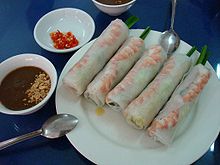 Summer rolls with accompaniments
Summer rolls with accompaniments
Name Description Bánh cuốn Rice flour rolls stuffed with ground pork, prawns, and wood ear mushroom. They are eaten in a variety of ways with many side dishes, including one out of many kinds of chả (sausage). Bì cuốn Rice paper rolls with the bi (bì) mixture of thinly shredded pork and thinly shredded pork skin tossed with powdered toasted rice, among other ingredients, along with salad. Similar to summer rolls. Bò bía (Vietnamese-style popiah) Stir-fried jicama and carrots, Chinese sausage, shredded scrambled eggs, all wrapped with vermicelli noodle in a rice paper roll. Dipped into a spicy peanut sauce (with freshly roasted and ground peanuts). It is of Chinese (Hokkien/Chaozhou) origin, having been brought over by the immigrants. In Saigon (particularly in Cholon), it is common to see an old Teochew man or woman selling bò bía at their roadside stand. The name bò bía phonetically resembles its original name popiah in the Teochew language. Chả giò or Nem rán (Northern) A kind of spring roll (sometimes referred to as egg roll) – deep-fried flour rolls filled with pork, yam, crab, shrimp, rice vermicelli, mushrooms ("wood ear" variety) and other ingredients. The spring roll goes by many names - as many people actually use (falsely) the word "spring roll" while referring to the fresh transparent rice paper rolls (discussed below as "Summer Rolls"), where the rice paper is dipped into water to soften and then rolled up with various ingredients. Traditionally these rolls are made with a rice paper wrapper but in recent years Vietnamese chefs outside of Vietnam have changed the recipe to use a wheat-flour-based wrapper. Gỏi cuốn (Salad rolls) Also known as Vietnamese fresh rolls, or summer rolls. They are rice paper rolls that often include shrimp, herbs, pork, rice vermicelli and other ingredients wrapped up and dipped in nước chấm or peanut sauce. Spring rolls almost constitute an entire category of Vietnamese foods, as there are numerous different kinds of spring rolls with different ingredients in them. Bánh tráng can be understood as either of the following:
- thin rice flour sheet dried into what is commonly called "rice paper", used in making spring roll (aka chả giò), and summer rolls (aka gỏi cuốn) by applying some water to soften the texture.
- Bánh tráng nướng (in the South), or bánh đa in the North
- These are large round flat rice crackers, which, when heated, enlarge into round, easily shattered pieces. They can be eaten separately, although they are most commonly added into the vermicelli noodle dishes like cao lầu and Mì Quảng. Many types of 'bánh tráng' exist, including the clear sesame seed ones, prawn-like cracker with dried spring onions, sweet milk, and so on.
Sandwiches
Main article: Bánh mìName Description Bánh mì kẹp thịt Vietnamese baguette or French bread containing pâté, Vietnamese mayonnaise, different selections of Vietnamese cold cuts (of which there is a large variety, most commonly ham, head cheese, and a Vietnamese bologna), pickled daikon, pickled carrot, and cucumber slices. The sandwich is often garnished with coriander leaves and black pepper. This food is common everywhere in Vietnam as a favorite of factory workers and students, and eaten for any meal of the day, commonly breakfast and lunch. There are a wide variety of bánh mì (with different meats) and many shops have popped up across North America serving primarily Bánh mì. Bánh mì trứng (Breakfast Bánh mì) This can be stuffed with scrambled eggs and canned sardines, or the more popular version: eggs fried sunny-side-up with onions, sprinkled with soy sauce and eaten with a fresh (and sometimes buttered) baguette. Bánh Pâté Chaud A French inspired meat-filled pastry. Characterized by flaky crust and either pork or chicken as the filling. Meat dishes
Name Description Bò kho (Meat Soup) A beef and vegetable stew, often cooked with warm, spicy herbs and served very hot with French baguettes for dipping. In northern Vietnam, it is known as "bò sốt vang" Bò lá lốt A dish of spiced beef rolled in a pepper leaf (lá lốt) and grilled. Bò lúc lắc (Shaking beef) A dish of beef cut into cubes and marinated, served over greens (usually watercress), and sautéed onions and tomatoes. Eaten with rice. Bò 7 món (Vietnamese seven courses of Beef) A less popular version is the Cá 7 Món, seven courses of fish. Chả lụa A sausage made with ground lean pork and potato starch. Also available fried; known as chả chiên. There are various kinds of chả (sausage), made of ground chicken (chả gà), ground beef (chả bò), fish (chả cá), or tofu (chả chay, or vegetarian sausage). Gà nướng sả Grilled chicken with lemon grass(sả). Lemon grass grilled beef and other meats are also popular variations. Nem nướng Grilled meatballs, usually made of seasoned pork. Often colored reddish with food coloring and with a distinct taste, grilled on skewers like kebabs. Ingredients in the marinade include fish sauce. Nem Nguội A Huế dish and a variation of the Nem nướng meatballs, these also come from Central Vietnam. They are chilled, small and rectangular in shape, and stuffed with vermicelli. The reddish meat is covered with peppers and typically a chili. Very spicy, eaten almost exclusively as a cocktail snack. Seafood dishes
Name Description Cá cuốn A roll with fish and spring onions. Cá kho tộ Caramelized fish in clay pot. Chạo tôm Prawn paste/cake on sugarcane. Salads
Gỏi is Vietnamese salad. Many varieties with the most popular including:
Name Description Gỏi đu đủ Vietnamese papaya Salad typically with shredded papaya, herbs, various meats such as shrimp, slices of pork, liver, or jerky, herbs, and with a more vinegar-based rendition of nước chấm. Gỏi Huế rau muống A salad dish originating from Huế (Central Vietnam), including water spinach (Rau Muống). Gỏi ngó sen Lotus stem salad, with shrimp and pork or chicken. Goi Ga Chicken and cabbage salad. Curries
- Vietnamese curry is also popular, especially in the south. Curry chicken can be either similar to the Thai curries with coconut milk or similar to Caribbean curries, stir-fried with no coconut milk. It is usually served with bread, rice, or noodles.
- Another type of well-known Vietnamese curry is beef brisket curry or oxtail curry. The beef curries are often served with French bread for dipping, or with rice.
- Cà ri gà is a popular Vietnamese curry that is made with chicken, carrots, sweet potatoes, and peas in a coconut curry sauce. It is also served with rice or baguette.
Pickled vegetable dishes
Dưa muối is Vietnamese term for this.
Name Description Dưa chua, Dưa cải muối chua Made from a kind of mustard green Cà bát muối xổi Made from a kind of eggplant Dưa kiệu Made from Allium chinense. This is a dish of Tết holiday. Dưa hành Made from onion bulbs. Dưa món Made from carrot, daikon, green papaya,... Fermented fishes or shrimps
Mắm is a Vietnamese term for fermented fish or shimps. Mắm is used as main course, ingredients or condiments. The types of fish most commonly used to make mắm are catfish, snakeheads, and mackerels. The fish flesh remains intact (this is how it is different from nước mắm), and can be eaten cooked or uncooked, with or without vegetables and condiments.
Name Description Mắm tôm Made from fermented shrimps. Mắm cá thu Made from mackerel fish. This is usually made in Bình Định province. Mắm nêm Usually made from round scad fish. This is a dish of Central Vietnam. Mắm tôm chua Made from shrimp, green papaya. This is a dish of Huế city. Mắm ruốc Made from krills. This is a dish from Central Vietnam. Mắm cá linh Made from a kind of fish that immigrates to Mekong delta every flood season from Tonlé Sap, Cambodia. Sour fermented meat dishes
Nem chua is Vietnamese term for this. Nem chua is used instantly or being fried. Nem chua is made from pork meat, coated by fried rice (thính gạo), mixed with pork skin and then wrapped in country gooseberry's leaves (lá chùm ruột) or Erythrina orientalis's leaves (lá vông nem). The preservation process will finish in about 3–5 days.
Nem chua has its variations in many areas: Vĩnh Yên, Ước Lễ village (Hà Đông), Vẽ village (Hà Nội), Quảng Yên (Quảng Ninh), Thanh Hóa, Đông Ba (Huế), Ninh Hòa (Khánh Hòa), Thủ Đức (Ho Chi Minh city), Lai Vung (Đồng Tháp), v.v...
Sausage
See Giò lụa
The Vietnamese term for sausage is giò, usually made from fresh ground pork and beef. Sausage makers may use their meat, skin or ear. Fish sauce is added before banana leaves are used to wrapped. The last step is boiling. For common sausage, 1 kg meat is boiled for 1 hour. For chả quế, the boiled meat mixture will then be roasted with cinnamon.
Vegetarian dishes
Main article: Buddhist cuisineSweets
Chè
Chè is a type of desert commonly made by boiling beans or a starchy root such as yam or taro in water and sugar. Coconut milk and shredded coconuts are commonly added to chè, especially in southern Vietnam.
Fruit preserves
Vietnamese use fruits in season. When the season is passing, they made fruit preserves, called ô mai in Vietnamese language. The natural taste of ô mai is a requirement. The original taste of ô mai is sour, sweet, salty and spicy. The most famous kind of ô mai is ô mai mơ, made from apricot harvested from the forest around Perfume pagoda (chùa Hương), Hà Tây province. This ô mai consists of apricot covered by ginger, sugar, liquorice root slivers. Ô mai is a favourite food of Vietnamese school girls.
Tofu
Tofu (Vietnamese: đậu hũ) is widely used in Vietnamese cuisine. Tofu is boiled, fried (sprinkled by ground shrimp or oil-dipped minced spring onion) or used as ingredient in a variety of dishes.
Other soybean products ranges from soy sauce (nước tương)- usually light soy sauce, fermented bean paste (tương), fermented bean curd (đậu phụ nhự or chao) to douhua (soft tofu sweet soup- tàu hũ nước đường).
Pastries
See Bánh lá
The Vietnamese name for pastries is bánh. Most Vietnamese pastries is made by leaf- wrapping and boiling. The most famous pair of cake is square cake (bánh chưng) symbolizing the Earth and a round cake (bánh dày) symbolizing the Heaven, which are used in Vietnamese New Year (Tết).
Condiments and sauces
Condiments
Vietnamese usually use raw vegetables as condiments for their dishes. It named rau sống (literally: raw vegetable) or rau ghém (literally: sliced vegetable). It combines properly with each main dish in flavour. For some dishes, rau sống could come into almost all the flavours: sour, bitter, spicy,...Dishes in which rau sống is indispensable are bánh xèo and hot pot. The vegetables principally are herbs and wild edible vegetables gathered from forests and family gardens. Leaves and buds are the most common parts of vegetables used. Most of the vegetables have medicinal value.
Rau sống includes:
- Lettuce (xà lách)
- Raw bean sprout (giá sống)
- Herbs (rau thơm)
- Shreded banana flower (bắp chuối bào)
- Green banana (chuối xanh)
- Split water spinach (rau muống chẻ)
- Mango bud (đọt xoài)
- Guava leaves (lá ổi)
Match
- Chicken dishes are combined with lime leaves.
- Crab and seashell dishes are combined with fishy smell herb and perilla.
Sauces
- Mắm tôm (shrimp paste)
- Nước mắm (fish extract) The fish sauce can be used as it is or mixed with lemon juice, garlic, vinegar, sugar, and chili. This mixture is called Nước mắm pha
- Tương Made from fermented soybeans
- Soya sauce, mostly used in marinades and sauces.
- Hot chili sauce
Food colourings
The colour of Vietnamese food comes from natural ingredients.
- Red: usually from Joseph's coat or by frying annatto seed to make oil (dầu điều)
- Yellow: for sticky rice, comes from Gac or turmeric
- Green: from pandan leaf or katuk
- Purple: from magenta plant (lá cẩm)
- Black: of gai cake is from ramie leaf (lá gai)
- Dark brown: for stew dishes, using nước màu or nước hàng, which is made by heating sugar to the temperature above that of caramel (170 °C).
Colourings can be absorbed by mixing ground colourings or colouring liquid or wraping before boiling to get the extracts. When colouring dishes, the tastes and smells of colourings must also be considered.
Herbs and spices
- Coriander leaves/Cilantro and green onion leaf can be used in almost all dishes.
- A basic technique of stir-frying vegetable is frying garlic or shallot with oil before put vegetable into the pan.
- In Northern Vietnam, all dishes with fish must be garnished with dill.
- In Central Vietnam, the mixture of ground lemon grass and chilli[disambiguation needed
 ] are frequently used in dishes with beef.
] are frequently used in dishes with beef. - In Southern Vietnam, coconut water is used in most stew dishes.
- The pair culantro (ngò gai) and rice paddy herb (ngò om or ngổ) is indispensable in all kinds of sour soups in the Southern Vietnam.
- Spearmint is often used with strongly fishy fishes.
- Perilla is usually used with crab dishes.
Desserts
Name Description Chè A sweet dessert beverage or pudding usually made from beans and sticky rice. Many varieties of chè are available, each with different fruits, beans (for example, mung beans or kidney beans), and other ingredients. Chè can be served cold – such as sâm bổ lường, which includes dried jujube, longan, fresh seaweed, barley and lotus seeds – or hot. Rau câu A popular gelatin dessert cake made with agar and flavored with coconut milk, pandan or other flavors. Because the gelatin is firm in texture compared to American gelatin, Vietnamese gelatin can be layered and shaped into intricate cakes. The gelatin is often called sương sa. Chuối Chiên Banana fried in a batter and often served hot with cold ice cream, usually vanilla or coconut. Bánh Flan Influenced by French cuisine and served with caramel sauce. Sinh tố Smoothie
A fruit smoothie made with just a few teaspoons of sweetened condensed milk, crushed ice and fresh local fruits. The smoothies come in many varieties including custard apple, sugar apple, avocado, jackfruit, durian, strawberry, passionfruit, dragonfruit, lychee, mango, and banana. Da Ua Made with condensed milk and has a sweet, tart flavor. It can be eaten in its cool, soft form or frozen. In Vietnam, it can be seen served frozen in small, clear bags. There are also various cakes and confections made with any combination of sweet beans, tropical fruit and glutinous rice.
Beverages
Name Description Bia hơi A Vietnamese specialty draft beer produced locally in small batches. Cà phê sữa đá Strong iced coffee, most often served with sweetened condensed milk at the bottom of the cup to be stirred in. The beverage is very popular among the Vietnamese. Nước mía Sugar cane juice extracted from squeezing sugar cane plant, served with ice. Rau má Pennywort juice made from blending fresh pennywort leaves with water and sugar until dissolved. The beverage is a near-transparent green color and served over ice. (tropical sorbets) Sữa đậu nành (Soy milk) A soybean drink served either hot or cold, sweetened or unsweetened. Rượu đế A distilled liquor made of rice. Trà đá A kind of ice tea popular for its cheap price. Has a faint lime-yellow color and usually doesn't have much taste. Nước sắn dây hoa bưởi Made of kudzu and pomelo flower extract. Exotic dishes
The use of ingredients that are typically uncommon or taboo in most countries is one of the quintessential attributes that make Vietnamese cuisine unique. Television chef Andrew Zimmern visited Vietnam in the twelfth episode of his popular show Bizarre Foods with Andrew Zimmern. Cobra beating heart and dried bones, silk worms and bull penis are some examples of the dishes he sampled.
In some countries, unusual ingredients, most of the time, can be found only in exotic restaurants. What makes the use of these ingredients in Vietnam stand out is that ingredients that are deemed atypical in most countries can play a customary role in daily family dishes, from the poor's to the riches'.
A common and inexpensive breakfast dish that can be found in any wet market, balut or hột vịt lộn is a fertilized duck egg with a nearly developed embryo inside which is boiled and eaten in the shell. It is typically served with fresh herbs: rau răm or Vietnamese coriander, salt, and pepper; lime juice is another popular additive, when available. A more unusual version of balut dish - Fetus quails ("trứng cút lộn")- is a snack favored by many Vietnamese students. Paddy crab and paddy snail are the main ingredients in "bún riêu ốc" - a popular noodle dish - and in some everyday soup dishes ("canh") and braised food ("món bung"). Family meals with silk worms ("nhộng"), banana flowers ("hoa chuối"), sparrows, doves, fermented fish and shrimp ("mắm cá, mắm tôm tép") are not rare sights. Seasonal favorites include ("rươi") or ragworm, which are made into many dishes such as fried "rươi" omelet ( chả rươi), fermented "rươi" sauce (mắm rươi), steamed rươi (rươi hấp), stir-fried rươi with radish or bamboo shoot (rươi xào củ niễng măng tươi hay củ cải).
Vietnamese cuisine is also notable for its wide range of meat choices. Exotic meat such as dog meat, snake, soft-shell turtle, deer and domestic goat are sold in street-side restaurants and generally paired with alcoholic beverages. A taboo in many Western countries, consumption of dog meat is a common sight throughout the country and is believed to raise the libido in men. Paddy mouse meat - barbecued, braised, stir- or deep-fried - is a rarer dish that can be found in many Vietnamese rural areas or even high-end city restaurants.
Anthony Bourdain, the host chef of Travel Channel's Anthony Bourdain: No Reservations, wrote in April 2005, for the Financial Times, "...everything is used - and nothing wasted in Vietnam." Animal parts that are often disposed of in many Western countries are utilized fully in Vietnamese cooking. Organs, including lungs, livers, hearts, intestines and bladders of pigs, cows and chickens are sold at an even higher price than their meat. Chicken testicles and undeveloped eggs are stir-fried with vegetables and served as an everyday dish.
Many of the traditional Northern Lunar New Year - Tết - dishes such as thịt đông, giò thủ, canh măng móng giò involve the use of pig heads, tongues, throats and feet. Pig and cow tails as well as chicken heads, necks and feet are Vietnamese favorite beer dishes. Bóng, used as an ingredient in "canh bóng" – a kind of soup, is pig skin baked until popped. Steamed pig brains can be found anywhere along a Vietnamese street. Different kinds of animal blood is made into tiết canh by whisking the blood with fish sauce and cold water in a shallow dish along with finely chopped cooked duck innards (such as gizzards), sprinkled with crushed peanuts and chopped herbs such as Vietnamese coriander, mint, etc. It is then cooled until the blood coagulates into a soft jelly-like mixture and served raw.
Common ingredients
Further information: List of Vietnamese ingredientsVegetables
- Bitter melon (khổ qua)
- Bok choy (cải bó xôi)
- Cabbage (cải bắp)
- Carrot (cà rốt)
- Cauliflower (súp lơ or bông cải)
- Ceylon spinach (mồng tơi)
- Chayote (su su)
- Chili pepper (ớt)
- Cucumber (dưa leo)
- Crown daisy (cải cúc or tần ô)
- Daikon (củ cải trắng)
- Eggplant (cà tím)
- Jicama (củ đậu or củ sắn)
- Hemlock water dropwort (rau cần ta)
- Katuk (rau ngót)
- Joseph's coat (rau dền đỏ)
- Tonkin jasmine (hoa thiên lý)
- Water cress (cải xong)
- Water spinach (rau muống)
Fruits
- Acerola (sơ ri or xê-ri)
- Buddha's hand (phật thủ)
- Canistel (trái trứng gà)
- Cherimoya (mãng cầu tây)
- Coconut (dừa)
- Chinese date (táo tàu)
- Custard apple (bình bát or mãng cầu)
- Durian (sầu riêng)
- milk fruit (vú sữa)
- Guava (ổi)
- Jackfruit (mít)
- Rambutan (chôm chôm)
- Sapodilla (hồng xiêm or xa-pô-chê)
- Spondias cytherea; see Spondias genus (cóc)
- Soursop (mãng cầu Xiêm)
- Star fruit (khế)
- Sweetsop (na or mãng cầu ta)
- Rose apple (roi in the North, mận Đà Lạt in the South)
- Tomato (cà chua)
- Water apple (roi in the north, mận in the south)
- Watermelon (dưa hấu)
Herbs (rau thơm)
- Genus Allium:
- Using leaf and flower: scallion or green onion (hành lá or hành hương or hành hoa), Chinese chives (hẹ)
- Using bulb: garlic (tỏi), shallot (hành tím), onion (hành tây), Allium chinense (củ kiệu) and chives (củ nén or hành tăm).
- Welsh onion (hưng cừ) and leek (tỏi tây or hành boarô) are not traditionally used.
- Family Zingiberaceae: using ginger (gừng), galangal (riềng)- greater galangal (riềng nếp) is preferred to lesser galangal (riềng thuốc) because of the stronger flavour, turmeric (nghệ) and black cardamom (thảo quả).
- Bacopa monnieri (rau đắng)
- Coriander (rau ngò or ngò rí)
- Spearmint (húng lủi)
- Elsholtzia ciliata (kinh giới)
- Lemon grass (xả or sả)
- Long coriander/culantro (ngò gai)
- Peppermint (húng cây or rau bạc hà)
- Perilla (tía tô)
- Rice paddy herb (ngò ôm)
- Houttuynia cordata (giấp cá or diếp cá)
- Thai basil (rau quế, húng quế, or rau húng quế) sometimes substituted with sweet basil in the United States
- Vietnamese coriander (rau răm)
- Dill (thì là)
- Parsley
Vietnamese utensils
- Basket, various kinds (rổ or rá)
- Bowl (small bowl: bát in Northern Vietnam or chén in Southern Vietnam; large bowl: tô)
- Chopsticks (đũa)
- Chõ- a kind of steamer to cook glutinous rice
- Clay pot cooking (thố đất)
- Cup (cốc or ly)
- Dipper (gáo)
- Flat drying basket (nong or nia)
- Knife (dao)
- Mill (cối xay gạo)
- Mortar (cối giã)
- Pestle (chày)
- Plate (dĩa or đĩa)
- Pot, various kinds (nồi and niêu)
- Spoon (thìa in Northern Vietnam or muỗng in Southern Vietnam)
- Teacup (tách or chén uống trà)
- Teapot (ấm pha trà)
- Tray, various kinds (mâm and khay)
See also
- List of Vietnamese dishes
- List of Vietnamese culinary specialities
- List of Vietnamese produce varieties
- List of Vietnamese ingredients
- Vietnamese noodles
- Vietnamese wine
- Rượu đế rice wine
- Basa fish
References
Footnotes
- ^ Dang, Vinh. "Bún 101". Vietnam Talking Points. One Vietnam Network. http://talk.onevietnam.org/bun-101/. Retrieved 16 September 2010.
Notations
- Nguyen, Andrea Quynhgiao; Cost, Bruce (FRW); Beisch, Leigh. (2006) Into the Vietnamese kitchen: treasured foodways, modern flavors. Ten Speed Press, ISBN 1-58008-665-9
- Le, Ann; Fay, Julie. (2006) The Little Saigon Cookbook: Vietnamese Cuisine and Culture in Southern California's Little Saigon, Globe Pequot, ISBN 0-7627-3831-6
- Thị Chơi Triệu, Marcel Isaak, (1998) The Food of Vietnam: Authentic Recipes from the Heart of Indochina, Tuttle Publishing, ISBN 962-593-394-8
- McDermott, Nancie; Alpert, Caren (2005) Quick & Easy Vietnamese: 75 Everyday Recipes Chronicle Books, ISBN 0-8118-4434-X
- Chi Nguyen; Judy Monroe, (2002) Cooking the Vietnamese way: revised and expanded to include new low-fat and vegetarian recipes Twenty-First Century Books, ISBN 0-8225-4125-4
- Pauline Nguyen; Luke Nguyen; Mark Jensen (2007), Secrets of the Red Lantern: Stories and Vietnamese Recipes from the Heart Murdoch Books, ISBN 1-74045-904-0
- Trieu Thi Choi, Thị Chơi Triệu, Marcel Isaak, Heinz Von Holzen (2005), Authentic Recipes from Vietnam Tuttle Publishing, ISBN 0-7946-0327-0
Asian cuisine Sovereign
states- Afghanistan
- Armenia
- Azerbaijan
- Bahrain
- Bangladesh
- Bhutan
- Brunei
- Burma (Myanmar)
- Cambodia
- People's Republic of China
- Cyprus
- East Timor (Timor-Leste)
- Egypt
- Georgia
- India
- Indonesia
- Iran
- Iraq
- Israel
- Japan
- Jordan
- Kazakhstan
- North Korea
- South Korea
- Kuwait
- Kyrgyzstan
- Laos
- Lebanon
- Malaysia
- Maldives
- Mongolia
- Nepal
- Oman
- Pakistan
- Philippines
- Qatar
- Russia
- Saudi Arabia
- Singapore
- Sri Lanka
- Syria
- Tajikistan
- Thailand
- Turkey
- Turkmenistan
- United Arab Emirates
- Uzbekistan
- Vietnam
- Yemen
States with limited
recognition- Abkhazia
- Nagorno-Karabakh
- Northern Cyprus
- Palestine
- Republic of China (Taiwan)
- South Ossetia
Dependencies and
other territoriesCuisine of Southeast Asia - Brunei
- Burma
- Cambodia
- East Timor
- Indonesia
- Laos
- Malaysia
- Philippines
- Singapore
- Thailand
- Vietnam
Categories:
Wikimedia Foundation. 2010.



